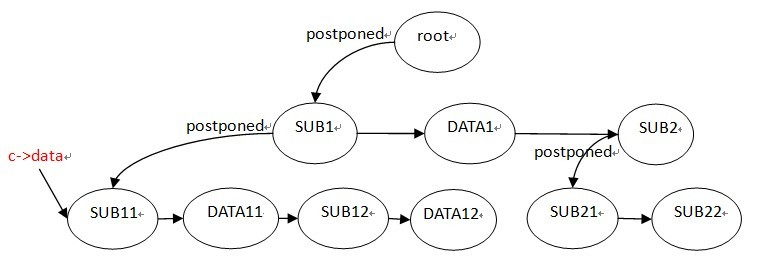### subrequest原理解析[](http://tengine.taobao.org/book/chapter_12.html#subrequest-99 "永久链接至标题")
子请求并不是http标准里面的概念,它是在当前请求中发起的一个新的请求,它拥有自己的ngx_http_request_t结构,uri和args。一般来说使用subrequest的效率可能会有些影响,因为它需要重新从server rewrite开始走一遍request处理的PHASE,但是它在某些情况下使用能带来方便,比较常用的是用subrequest来访问一个upstream的后端,并给它一个ngx_http_post_subrequest_t的回调handler,这样有点类似于一个异步的函数调用。对于从upstream返回的数据,subrequest允许根据创建时指定的flag,来决定由用户自己处理(回调handler中)还是由upstream模块直接发送到out put filter。简单的说一下subrequest的行为,nginx使用subrequest访问某个location,产生相应的数据,并插入到nginx输出链的相应位置(创建subrequest时的位置),下面用nginx代码内的addition模块(默认未编译进nginx核心,请使用–with-http_addition_module选项包含此模块)来举例说明一下:
[](http:// "点击提交Issue,反馈你的意见...")
location /main.htm {
# content of main.htm: main
add_before_body /hello.htm;
add_after_body /world.htm;
}
location /hello.htm {
#content of hello.htm: hello
}
location /world.htm {
#content of world.htm: world
}
访问/main.htm,将得到如下响应:
[](http:// "点击提交Issue,反馈你的意见...")
hellomainworld
上面的add_before_body指令发起一个subrequest来访问/hello.htm,并将产生的内容(hello)插入主请求响应体的开头,add_after_body指令发起一个subrequest访问/world.htm,并将产生的内容(world)附加在主请求响应体的结尾。addition模块是一个filter模块,但是subrequest既可以在phase模块中使用,也可以在filter模块中使用。
在进行源码解析之前,先来想想如果是我们自己要实现subrequest的上述行为,该如何来做?subrequest还可能有自己的subrequest,而且每个subrequest都不一定按照其创建的顺序来输出数据,所以简单的采用链表不好实现,于是进一步联想到可以采用树的结构来做,主请求即为根节点,每个节点可以有自己的子节点,遍历某节点表示处理某请求,自然的可以想到这里可能是用后根(序)遍历的方法,没错,实际上Igor采用树和链表结合的方式实现了subrequest的功能,但是由于节点(请求)产生数据的顺序不是固定按节点创建顺序(左->右),而且可能分多次产生数据,不能简单的用后根(序)遍历。Igor使用了2个链表的结构来实现,第一个是每个请求都有的postponed链表,一般情况下每个链表节点保存了该请求的一个子请求,该链表节点定义如下:
[](http:// "点击提交Issue,反馈你的意见...")
struct ngx_http_postponed_request_s {
ngx_http_request_t *request;
ngx_chain_t *out;
ngx_http_postponed_request_t *next;
};
可以看到它有一个request字段,可以用来保存子请求,另外还有一个ngx_chain_t类型的out字段,实际上一个请求的postponed链表里面除了保存子请求的节点,还有保存该请求自己产生的数据的节点,数据保存在out字段;第二个是posted_requests链表,它挂载了当前需要遍历的请求(节点), 该链表保存在主请求(根节点)的posted_requests字段,链表节点定义如下:
[](http:// "点击提交Issue,反馈你的意见...")
struct ngx_http_posted_request_s {
ngx_http_request_t *request;
ngx_http_posted_request_t *next;
};
在ngx_http_run_posted_requests函数中会顺序的遍历主请求的posted_requests链表:
[](http:// "点击提交Issue,反馈你的意见...")
void
ngx_http_run_posted_requests(ngx_connection_t *c)
{
...
for ( ;; ) {
/* 连接已经断开,直接返回 */
if (c->destroyed) {
return;
}
r = c->data;
/* 从posted_requests链表的队头开始遍历 */
pr = r->main->posted_requests;
if (pr == NULL) {
return;
}
/* 从链表中移除即将要遍历的节点 */
r->main->posted_requests = pr->next;
/* 得到该节点中保存的请求 */
r = pr->request;
ctx = c->log->data;
ctx->current_request = r;
ngx_log_debug2(NGX_LOG_DEBUG_HTTP, c->log, 0,
"http posted request: \"%V?%V\"", &r->uri, &r->args);
/* 遍历该节点(请求) */
r->write_event_handler(r);
}
}
ngx_http_run_posted_requests函数的调用点后面会做说明。
了解了一些实现的原理,来看代码就简单多了,现在正式进行subrequest的源码解析, 首先来看一下创建subrequest的函数定义:
[](http:// "点击提交Issue,反馈你的意见...")
ngx_int_t
ngx_http_subrequest(ngx_http_request_t *r,
ngx_str_t *uri, ngx_str_t *args, ngx_http_request_t **psr,
ngx_http_post_subrequest_t *ps, ngx_uint_t flags)
参数r为当前的请求,uri和args为新的要发起的uri和args,当然args可以为NULL,psr为指向一个ngx_http_request_t指针的指针,它的作用就是获得创建的子请求,ps的类型为ngx_http_post_subrequest_t,它的定义如下:
[](http:// "点击提交Issue,反馈你的意见...")
typedef struct {
ngx_http_post_subrequest_pt handler;
void *data;
} ngx_http_post_subrequest_t;
typedef ngx_int_t (*ngx_http_post_subrequest_pt)(ngx_http_request_t *r,
void *data, ngx_int_t rc);
它就是之前说到的回调handler,结构里面的handler类型为ngx_http_post_subrequest_pt,它是函数指针,data为传递给handler的额外参数。再来看一下ngx_http_subrequest函数的最后一个是flags,现在的源码中实际上只有2种类型的flag,分别为NGX_HTTP_SUBREQUEST_IN_MEMORY和NGX_HTTP_SUBREQUEST_WAITED,第一个就是指定文章开头说到的子请求的upstream处理数据的方式,第二个参数表示如果该子请求提前完成(按后序遍历的顺序),是否设置将它的状态设为done,当设置该参数时,提前完成就会设置done,不设时,会让该子请求等待它之前的子请求处理完毕才会将状态设置为done。
进入ngx_http_subrequest函数内部看看:
[](http:// "点击提交Issue,反馈你的意见...")
{
...
/* 解析flags, subrequest_in_memory在upstream模块解析完头部,
发送body给downsstream时用到 */
sr->subrequest_in_memory = (flags & NGX_HTTP_SUBREQUEST_IN_MEMORY) != 0;
sr->waited = (flags & NGX_HTTP_SUBREQUEST_WAITED) != 0;
sr->unparsed_uri = r->unparsed_uri;
sr->method_name = ngx_http_core_get_method;
sr->http_protocol = r->http_protocol;
ngx_http_set_exten(sr);
/* 主请求保存在main字段中 */
sr->main = r->main;
/* 父请求为当前请求 */
sr->parent = r;
/* 保存回调handler及数据,在子请求执行完,将会调用 */
sr->post_subrequest = ps;
/* 读事件handler赋值为不做任何事的函数,因为子请求不用再读数据或者检查连接状态;
写事件handler为ngx_http_handler,它会重走phase */
sr->read_event_handler = ngx_http_request_empty_handler;
sr->write_event_handler = ngx_http_handler;
/* ngx_connection_s的data字段比较关键,它保存了当前可以向out chain输出数据的请求,
具体意义后面会做详细介绍 */
if (c->data == r && r->postponed == NULL) {
c->data = sr;
}
/* 默认共享父请求的变量,当然你也可以根据需求在创建完子请求后,再创建子请求独立的变量集 */
sr->variables = r->variables;
sr->log_handler = r->log_handler;
pr = ngx_palloc(r->pool, sizeof(ngx_http_postponed_request_t));
if (pr == NULL) {
return NGX_ERROR;
}
pr->request = sr;
pr->out = NULL;
pr->next = NULL;
/* 把该子请求挂载在其父请求的postponed链表的队尾 */
if (r->postponed) {
for (p = r->postponed; p->next; p = p->next) { /* void */ }
p->next = pr;
} else {
r->postponed = pr;
}
/* 子请求为内部请求,它可以访问internal类型的location */
sr->internal = 1;
/* 继承父请求的一些状态 */
sr->discard_body = r->discard_body;
sr->expect_tested = 1;
sr->main_filter_need_in_memory = r->main_filter_need_in_memory;
sr->uri_changes = NGX_HTTP_MAX_URI_CHANGES + 1;
tp = ngx_timeofday();
r->start_sec = tp->sec;
r->start_msec = tp->msec;
r->main->subrequests++;
/* 增加主请求的引用数,这个字段主要是在ngx_http_finalize_request调用的一些结束请求和
连接的函数中使用 */
r->main->count++;
*psr = sr;
/* 将该子请求挂载在主请求的posted_requests链表队尾 */
return ngx_http_post_request(sr, NULL);
}
到这时,子请求创建完毕,一般来说子请求的创建都发生在某个请求的content handler或者某个filter内,从上面的函数可以看到子请求并没有马上被执行,只是被挂载在了主请求的posted_requests链表中,那它什么时候可以执行呢?之前说到posted_requests链表是在ngx_http_run_posted_requests函数中遍历,那么ngx_http_run_posted_requests函数又是在什么时候调用?它实际上是在某个请求的读(写)事件的handler中,执行完该请求相关的处理后被调用,比如主请求在走完一遍PHASE的时候会调用ngx_http_run_posted_requests,这时子请求得以运行。
这时实际还有1个问题需要解决,由于nginx是多进程,是不能够随意阻塞的(如果一个请求阻塞了当前进程,就相当于阻塞了这个进程accept到的所有其他请求,同时该进程也不能accept新请求),一个请求可能由于某些原因需要阻塞(比如访问io),nginx的做法是设置该请求的一些状态并在epoll中添加相应的事件,然后转去处理其他请求,等到该事件到来时再继续处理该请求,这样的行为就意味着一个请求可能需要多次执行机会才能完成,对于一个请求的多个子请求来说,意味着它们完成的先后顺序可能和它们创建的顺序是不一样的,所以必须有一种机制让提前完成的子请求保存它产生的数据,而不是直接输出到out chain,同时也能够让当前能够往out chain输出数据的请求及时的输出产生的数据。作者Igor采用ngx_connection_t中的data字段,以及一个body filter,即ngx_http_postpone_filter,还有ngx_http_finalize_request函数中的一些逻辑来解决这个问题。
下面用一个图来做说明,下图是某时刻某个主请求和它的所有子孙请求的树结构:
[](http://tengine.taobao.org/book/_images/chapter-12-1.png)
图中的root节点即为主请求,它的postponed链表从左至右挂载了3个节点,SUB1是它的第一个子请求,DATA1是它产生的一段数据,SUB2是它的第2个子请求,而且这2个子请求分别有它们自己的子请求及数据。ngx_connection_t中的data字段保存的是当前可以往out chain发送数据的请求,文章开头说到发到客户端的数据必须按照子请求创建的顺序发送,这里即是按后序遍历的方法(SUB11->DATA11->SUB12->DATA12->(SUB1)->DATA1->SUB21->SUB22->(SUB2)->(ROOT)),上图中当前能够往客户端(out chain)发送数据的请求显然就是SUB11,如果SUB12提前执行完成,并产生数据DATA121,只要前面它还有节点未发送完毕,DATA121只能先挂载在SUB12的postponed链表下。这里还要注意一下的是c->data的设置,当SUB11执行完并且发送完数据之后,下一个将要发送的节点应该是DATA11,但是该节点实际上保存的是数据,而不是子请求,所以c->data这时应该指向的是拥有改数据节点的SUB1请求。
下面看下源码具体是怎样实现的,首先是ngx_http_postpone_filter函数:
[](http:// "点击提交Issue,反馈你的意见...")
static ngx_int_t
ngx_http_postpone_filter(ngx_http_request_t *r, ngx_chain_t *in)
{
...
/* 当前请求不能往out chain发送数据,如果产生了数据,新建一个节点,
将它保存在当前请求的postponed队尾。这样就保证了数据按序发到客户端 */
if (r != c->data) {
if (in) {
ngx_http_postpone_filter_add(r, in);
return NGX_OK;
}
...
return NGX_OK;
}
/* 到这里,表示当前请求可以往out chain发送数据,如果它的postponed链表中没有子请求,也没有数据,
则直接发送当前产生的数据in或者继续发送out chain中之前没有发送完成的数据 */
if (r->postponed == NULL) {
if (in || c->buffered) {
return ngx_http_next_filter(r->main, in);
}
/* 当前请求没有需要发送的数据 */
return NGX_OK;
}
/* 当前请求的postponed链表中之前就存在需要处理的节点,则新建一个节点,保存当前产生的数据in,
并将它插入到postponed队尾 */
if (in) {
ngx_http_postpone_filter_add(r, in);
}
/* 处理postponed链表中的节点 */
do {
pr = r->postponed;
/* 如果该节点保存的是一个子请求,则将它加到主请求的posted_requests链表中,
以便下次调用ngx_http_run_posted_requests函数,处理该子节点 */
if (pr->request) {
ngx_log_debug2(NGX_LOG_DEBUG_HTTP, c->log, 0,
"http postpone filter wake \"%V?%V\"",
&pr->request->uri, &pr->request->args);
r->postponed = pr->next;
/* 按照后序遍历产生的序列,因为当前请求(节点)有未处理的子请求(节点),
必须先处理完改子请求,才能继续处理后面的子节点。
这里将该子请求设置为可以往out chain发送数据的请求。 */
c->data = pr->request;
/* 将该子请求加入主请求的posted_requests链表 */
return ngx_http_post_request(pr->request, NULL);
}
/* 如果该节点保存的是数据,可以直接处理该节点,将它发送到out chain */
if (pr->out == NULL) {
ngx_log_error(NGX_LOG_ALERT, c->log, 0,
"http postpone filter NULL output",
&r->uri, &r->args);
} else {
ngx_log_debug2(NGX_LOG_DEBUG_HTTP, c->log, 0,
"http postpone filter output \"%V?%V\"",
&r->uri, &r->args);
if (ngx_http_next_filter(r->main, pr->out) == NGX_ERROR) {
return NGX_ERROR;
}
}
r->postponed = pr->next;
} while (r->postponed);
return NGX_OK;
}
再来看ngx_http_finalzie_request函数:
[](http:// "点击提交Issue,反馈你的意见...")
void
ngx_http_finalize_request(ngx_http_request_t *r, ngx_int_t rc)
{
...
/* 如果当前请求是一个子请求,检查它是否有回调handler,有的话执行之 */
if (r != r->main && r->post_subrequest) {
rc = r->post_subrequest->handler(r, r->post_subrequest->data, rc);
}
...
/* 子请求 */
if (r != r->main) {
/* 该子请求还有未处理完的数据或者子请求 */
if (r->buffered || r->postponed) {
/* 添加一个该子请求的写事件,并设置合适的write event hander,
以便下次写事件来的时候继续处理,这里实际上下次执行时会调用ngx_http_output_filter函数,
最终还是会进入ngx_http_postpone_filter进行处理 */
if (ngx_http_set_write_handler(r) != NGX_OK) {
ngx_http_terminate_request(r, 0);
}
return;
}
...
pr = r->parent;
/* 该子请求已经处理完毕,如果它拥有发送数据的权利,则将权利移交给父请求, */
if (r == c->data) {
r->main->count--;
if (!r->logged) {
clcf = ngx_http_get_module_loc_conf(r, ngx_http_core_module);
if (clcf->log_subrequest) {
ngx_http_log_request(r);
}
r->logged = 1;
} else {
ngx_log_error(NGX_LOG_ALERT, c->log, 0,
"subrequest: \"%V?%V\" logged again",
&r->uri, &r->args);
}
r->done = 1;
/* 如果该子请求不是提前完成,则从父请求的postponed链表中删除 */
if (pr->postponed && pr->postponed->request == r) {
pr->postponed = pr->postponed->next;
}
/* 将发送权利移交给父请求,父请求下次执行的时候会发送它的postponed链表中可以
发送的数据节点,或者将发送权利移交给它的下一个子请求 */
c->data = pr;
} else {
/* 到这里其实表明该子请求提前执行完成,而且它没有产生任何数据,则它下次再次获得
执行机会时,将会执行ngx_http_request_finalzier函数,它实际上是执行
ngx_http_finalzie_request(r,0),也就是什么都不干,直到轮到它发送数据时,
ngx_http_finalzie_request函数会将它从父请求的postponed链表中删除 */
r->write_event_handler = ngx_http_request_finalizer;
if (r->waited) {
r->done = 1;
}
}
/* 将父请求加入posted_request队尾,获得一次运行机会 */
if (ngx_http_post_request(pr, NULL) != NGX_OK) {
r->main->count++;
ngx_http_terminate_request(r, 0);
return;
}
return;
}
/* 这里是处理主请求结束的逻辑,如果主请求有未发送的数据或者未处理的子请求,
则给主请求添加写事件,并设置合适的write event hander,
以便下次写事件来的时候继续处理 */
if (r->buffered || c->buffered || r->postponed || r->blocked) {
if (ngx_http_set_write_handler(r) != NGX_OK) {
ngx_http_terminate_request(r, 0);
}
return;
}
...
}
[](http:// "点击提交Issue,反馈你的意见...")
- 上篇:nginx模块开发篇
- nginx平台初探
- 初探nginx架构
- nginx基础概念
- connection
- request
- keepalive
- pipe
- lingering_close
- 基本数据结构
- ngx_str_t
- ngx_pool_t
- ngx_array_t
- ngx_hash_t
- ngx_hash_wildcard_t
- ngx_hash_combined_t
- ngx_hash_keys_arrays_t
- ngx_chain_t
- ngx_buf_t
- ngx_list_t
- ngx_queue_t
- nginx的配置系统
- 指令参数
- 指令上下文
- nginx的模块化体系结构
- 模块的分类
- nginx的请求处理
- handler模块
- handler模块简介
- 模块的基本结构
- 模块配置结构
- 模块配置指令
- 模块上下文结构
- 模块的定义
- handler模块的基本结构
- handler模块的挂载
- handler的编写步骤
- 示例: hello handler 模块
- handler模块的编译和使用
- 更多handler模块示例分析
- http access module
- http static module
- http log module
- 过滤模块
- 过滤模块简介
- 过滤模块的分析
- upstream模块
- upstream模块
- upstream模块接口
- memcached模块分析
- 本节回顾
- 负载均衡模块
- 配置
- 指令
- 钩子
- 初始化配置
- 初始化请求
- peer.get和peer.free回调函数
- 本节回顾
- 其他模块
- core模块
- event模块
- 模块开发高级篇
- 变量
- 下篇:nginx原理解析篇
- nginx架构详解
- nginx的源码目录结构
- nginx的configure原理
- 模块编译顺序
- nginx基础设施
- 内存池
- nginx的启动阶段
- 概述
- 共有流程
- 配置解析
- nginx的请求处理阶段
- 接收请求流程
- http请求格式简介
- 请求头读取
- 解析请求行
- 解析请求头
- 请求体读取
- 读取请求体
- 丢弃请求体
- 多阶段处理请求
- 多阶段执行链
- POST_READ阶段
- SERVER_REWRITE阶段
- FIND_CONFIG阶段
- REWRITE阶段
- POST_REWRITE阶段
- PREACCESS阶段
- ACCESS阶段
- POST_ACCESS阶段
- TRY_FILES阶段
- CONTENT阶段
- LOG阶段
- Nginx filter
- header filter分析
- body filter分析
- ngx_http_copy_filter_module分析
- ngx_http_write_filter_module分析
- subrequest原理解析
- https请求处理解析
- 附录A 编码风格
- 附录B 常用API
- 附录C 模块编译,调试与测试
